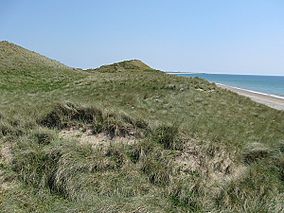Ballyteigue Burrow facts for kids
Quick facts for kids Ballyteigue Burrow |
|
|---|---|

The highest dune (14m) at Ballyteige Beach
|
|
| Location | County Wexford, Ireland |
| Area | 561 acres (2.27 km2) |
| Governing body | National Parks and Wildlife Service |
Ballyteigue Burrow is a really special place in County Wexford, Ireland. It's a national nature reserve, which means it's protected by the government. This amazing area covers about 561 acres (or 2.27 square kilometers) and has many different types of coastal habitats. It's also known as a Special Area of Conservation because of its important natural features.
Contents
Discover Ballyteigue Burrow's Unique Features
Ballyteigue Burrow became a national nature reserve in 1987. This means the Irish government legally protects it. It's also a Special Area of Conservation. Experts say this place is super important worldwide. This is because it has so many different natural areas. These include wet areas between dunes, salt marshes, sandy dunes, and mudflats.
The name "burrow" comes from the many rabbits that lived here. People even bred rabbits here since the time of the Normans! You can still find lots of European rabbits in the reserve. Their numbers go up and down because of a rabbit disease called myxomatosis.
Amazing Plants of the Burrow
Ballyteigue Burrow is home to some rare and protected plants. Four special plant species have been found here. These include lesser centaury, wild asparagus, Borrer's saltmarsh grass, and perennial glasswort. This reserve is the main place in Ireland where perennial glasswort grows. It's also the only place in Ireland where you can find the rare lichen called Fulgensia fulgens.
Other cool plants you might see include wild thyme and birds-foot trefoil. You can also spot common centaury, kidney vetch, and restharrow. Look out for spring vetch, sea pea, and henbane. Further away from the coast, the soil is more acidic. Here, marram grass is the most common plant on the sand dunes. Other interesting lichens like Usnea articulata and mosses like Tortula ruraliformis also live here.
Insects and Reptiles in the Dunes
The warm sand dunes are perfect for many insects. You'll find wasps, ants, and bees buzzing around. This includes two endangered bumble bees: the great yellow bumble bee and the shrill carder bee. Many moths and butterflies also fly here. Keep an eye out for the dark green fritillary and the small heath.
Small numbers of a rare woodlouse, the pale pill woodlouse Armadillidium album, have been found here. You might also spot the common lizard, Lacerta vivipara. Sadly, the number of these lizards has been going down.
Birdwatching at the Estuary
The area near the estuary (where the river meets the sea) is a vital winter home for many important birds. You can see pale-bellied Brent geese and lapwings. Black-tailed godwits and golden plovers also spend their winters here. The mudflats are full of different wading birds, swans, and ducks.
Other birds that live in the reserve include linnets and little terns. You might hear meadow pipits and reed buntings singing. Look up for skylarks, and spot stonechats, wheatears, and wrens.

